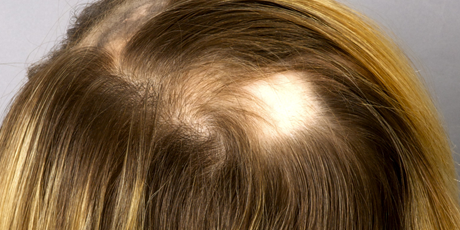Who can be affected | Causes | Diagnosis | Types | Prognosis
Alopecia areata is the condition where one encounters localized hair loss with patches of baldness. Hair loss onset is sudden and sometimes total baldness can occur over time. It is not associated with any internal or external medical problem. The reassuring factor is that in most cases, the hair grows back after some months and there is no visible scarring.
Who can be affected?
Alopecia areata can strike at any time. It affects people of all races and ethnic background. Highest incidence is found in the age group of 15- 30 years. Both men and women are affected; though with late onset, more women than men are afflicted. Late-onset alopecia is milder also. People with prior family history of alopecia and with family members having other autoimmune disease conditions are susceptible.
Causes
Alopecia areata is an auto-immune, T-cell referred condition. Immune system attacks the hair follicles. Weakened hair falls out in clumps leaving smooth patches of bald areas which is also one of the important causes. Sometimes noticeable thinning of hair only can occur without baldness. While hair grows in older bald patches, fresh hair-loss occurs in other areas. Damage to hair follicle is not permanent. Permanent hair loss can occur in about 10% of patients. Alopecia runs in families.
Diagnosis
When sudden hair-loss occurs and you see clumps of hair in the shower or on your pillow, you need to seek medical attention. The doctor will check personal, family medical history, conduct a physical exam including a scalp exam and may order blood tests and hair analysis. He will check nails for pitting and denting etc to diagnose this condition.
Types
There are different types of alopecia. Each causes a typical pattern of hair loss.
- Alopecia areata (hair-loss occurring in patches on the scalp)
- Patchy pattern
- Ophiasis pattern-Begins at the occiput and progresses anteriorly and bilaterally along the scalp margin in a band like fashion.
- Sisaphio-Inverse ophiasis pattern.
- Reticulate pattern.
- Diffuse pattern.
- Alopecia totalis (total hair-loss from the scalp)
- Alopecia universalis (total hair-loss throughout the body)
Alopecia in not infectious or contagious; occurs in people otherwise quite healthy. Total hair-loss type of alopecia is rare, only in about 5% of people. Sometimes the re-growth is much delayed or fails to happen.
Prognosis
Usually hair-loss is due to aging and sometimes due to hormonal changes. But sudden, excessive and visible hair loss like in alopecia can be worrisome and disheartening. Alopecia is not a medical crisis or life threatening condition. But psychological effects due to concern about loss of good looks, social isolation and low self-esteem can be devastating and far reaching. Correct diagnosis and treatment care consisting of topical and oral medications are essential along with cosmetic managements.
-
- WebMD – Hair Loss Center view
- MedicineNet – About Alopecia view
- Patient.co.uk (Original Author: Dr Tim Kenny) view
- National Institute of Health – Questions and Answers about Alopecia Areata view
- Dermatology – About.com (Heather Brannon, MD) view
- Medscape – Drugs, Diseases and Procedures [Alopecia Areata – Author: Chantal Bolduc, MD, FRCP(C); Chief Editor: Dirk M Elston, MD] view


 Dr. Batul Patel is a celebrity dermatologist and the medical director of The Bombay Skin Clinic an award winning clinic located in South Mumbai & Bandra. She is a passionate and dedicated dermatologist with expertise in all fields of dermatology, trichology and aesthetic dermatology. She has been practicing for more than a decade. Her range of expertise include emsculpt NEO, coolsculpting, fillers, acne treatment, lasers, skin rejuvenation, hair loss, hair transplant, PRP & pigmentation treatments.
Dr. Batul Patel is a celebrity dermatologist and the medical director of The Bombay Skin Clinic an award winning clinic located in South Mumbai & Bandra. She is a passionate and dedicated dermatologist with expertise in all fields of dermatology, trichology and aesthetic dermatology. She has been practicing for more than a decade. Her range of expertise include emsculpt NEO, coolsculpting, fillers, acne treatment, lasers, skin rejuvenation, hair loss, hair transplant, PRP & pigmentation treatments.